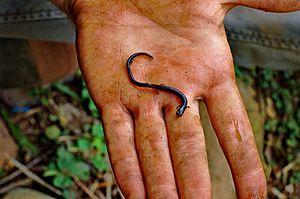Oedipina uniformis facts for kids
Quick facts for kids Oedipina uniformis |
|
|---|---|
 |
|
| Conservation status | |
| Scientific classification | |
| Synonyms | |
|
The Oedipina uniformis is a special kind of salamander. It belongs to the family Plethodontidae, which are known as lungless salamanders. This means they breathe through their skin and the lining of their mouths, not with lungs!
You can find this unique salamander in the mountains and lowlands of central Costa Rica. Its home stretches all the way to the border with Panama. It might even live in Panama too.
Contents
What is a Salamander?
Salamanders are amazing amphibians. They are related to frogs and newts. Most salamanders have four legs and a long tail. They look a bit like lizards, but their skin is smooth and moist, not scaly.
Amphibians: A Double Life
The word "amphibian" means "double life." This is because many amphibians start their lives in water. They often begin as larvae, like tadpoles. Then, they change and grow to live on land as adults.
Where the Oedipina uniformis Lives
This salamander loves places that are wet and cool. It lives in humid forests, especially in areas called premontane and lower montane forests. These are forests found on the lower slopes of mountains.
Finding a Home
The Oedipina uniformis hides in interesting spots. You can find it in leaf-litter on the forest floor. It also likes to live under decaying logs. Sometimes, it makes its home in soft moss banks. These places keep it safe and moist.
Adapting to Change
What's really cool about this salamander is how tough it is. It can handle big changes to its home. Even if its forest habitat is changed, it can still survive. People have found it in pastures where animals graze. It also lives in gardens and even in cities! This means it's not usually threatened by habitat loss, which is good news.
What it Looks Like
The Oedipina uniformis is a slender salamander. It has a long body and tail, which helps it move through tight spaces. Its skin is smooth and often dark, helping it blend in with its surroundings.
Breathing Without Lungs
Like all Plethodontidae salamanders, the Oedipina uniformis does not have lungs. Instead, it breathes through its skin. This is why it needs to stay in moist places. Its skin must be wet to absorb oxygen from the air. It also uses the lining of its mouth and throat to help with breathing.
Life Cycle and Reproduction
Like other amphibians, the Oedipina uniformis goes through a life cycle. This involves different stages of growth.
Eggs and Young
Female salamanders lay eggs. For many salamander species, the eggs are laid in water or in very moist places on land. The young salamanders hatch from these eggs. They often look like smaller versions of the adults.
Growing Up
As they grow, young salamanders eat small insects and other tiny creatures. They shed their skin as they get bigger, just like snakes do. This allows them to grow into adult salamanders.
What it Eats
The Oedipina uniformis is a carnivore, meaning it eats meat. It hunts for small invertebrates. These are creatures without backbones.
Forest Floor Feast
Its diet likely includes tiny insects, worms, and other small creatures found in the leaf-litter. It uses its quick tongue to catch its prey. This helps keep the forest ecosystem balanced.
Why This Salamander Matters
Every animal plays a role in its environment. The Oedipina uniformis helps keep insect populations in check. It is also a food source for other animals. Its ability to live in changed habitats makes it an interesting species for scientists to study. It shows how some animals can adapt to human activity.
See also
 In Spanish: Oedipina uniformis para niños
In Spanish: Oedipina uniformis para niños


